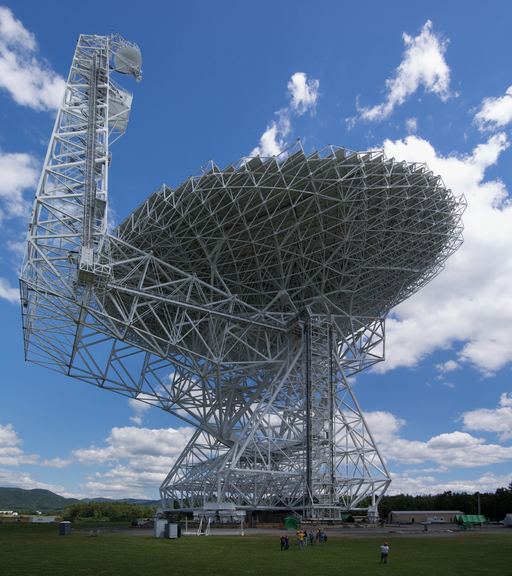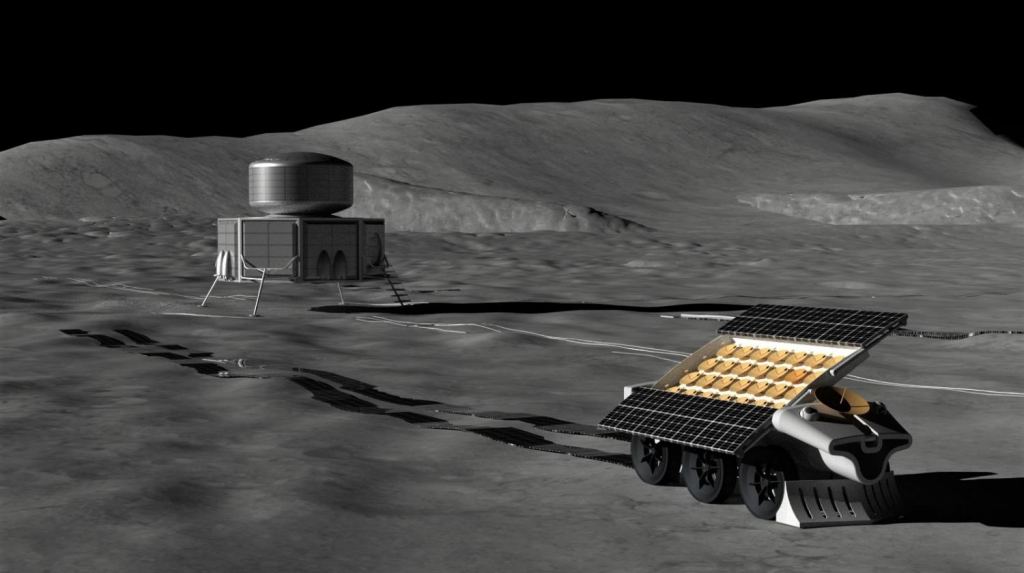The University of Colorado Boulder and Lunar Resources Inc. have just won NASA funding to study the possibility of building a radio telescope on the far side of the Moon. The project, called FarView, would harvest building materials from the Lunar surface itself, and use robotic rovers to construct a massive, intricate network of wires and antennas across 400 square kilometers. When complete, FarView would allow radio astronomers to observe the sky in low-frequency radio wavelengths with unprecedented clarity.
Radio telescopes work best in isolation. On Earth, if radio telescope operators want to ‘hear’ the sky without interference, they need to establish enormous exclusion zones around the telescope where cellphones, wi-fi, and even the spark-plugs from gasoline cars are banned. FarView proposes to put a telescope in the quietest place we can think of, away from Earthlings and our noisy gadgets. With this Lunar observatory, astronomers would be able to listen to the Universe more clearly than ever before, allowing them to go deeper back in time and space, perhaps even to the cosmic dark ages when the first stars were forming.

It just might work, although the plan is still in the earliest stages. FarView is funded by NASA’s Innovative Advanced Concepts (NIAC) program, which works with entrepreneurs to fund ideas that are innovative and technically sound, but largely untried and still in their infancy. NIAC projects are a glimpse at the possibilities of space exploration a decade or more in the future. It will be a long road yet to create the proposed Moon-based observatory.
Dr. Alex Ignatiev, Chief Technology Officer of Lunar Resources, is confident they can pull it off, and do so without breaking the bank. “We could build FarView at about 10% of the James Webb Telescope cost and operate for more than 50 years,” he said. It is an impressive goal.
Building with Lunar Soil
The key to keeping costs down is to build FarView using materials already available on the Moon, otherwise known as in-situ resource utilization (ISRU). ISRU has become a buzzword in recent years with regard to Lunar and Martian exploration, as it is will be necessary to sustain long-duration human activity on the Moon and Mars. In this instance, ISRU will allow FarView to reduce the expensive costs of escaping Earth’s pesky gravity well by building the telescope out of Lunar regolith.
The exact manufacturing process for FarView relies on two techniques. The first is molten regolith electrolysis (melting Lunar soil to separate the metals from the oxygen), and the second is vacuum deposition (laying down thin foil-like films of material). Lunar Resources has experience in both techniques on a small scale; they will need to be ramped up to create the enormous FarView observatory.
During a Future In-Space Operations (FISO) telecon presentation last December, Ignatiev explained that the regolith across the Moon is a mix of metallic oxides, with more iron in the Mares and more aluminum in the Highlands, and elements like silicon and magnesium available throughout. “Our challenge then in terms of doing manufacturing on the moon with raw materials,” he said, “is to break that regolith-oxygen bond…and obtain the raw elements from that regolith” using electric currents.

A small robotic processing factory would extract these metals from the soil, and deposit them into a rover. FarView’s Principal Investigator, Ronald Polidan, told FISO that as the rover drives along, it “melts the regolith surface into a glass, then lays the metal antennas on that, with connecting wires and all the other necessary infrastructure.” Using this method, it would take 26 months to fabricate the 100,000 ten-meter-long dipoles required for the telescope. The rover would only be able to work during the Lunar days (about two Earth weeks long) and have to hibernate during the nights.
Challenges and Opportunities
Building a Lunar telescope sounds complicated, but its principles are fairly straightforward once the materials are extracted. Laying strips of metal foil across the surface of the Moon shouldn’t be too hard, and no large-scale load-bearing construction is necessary for it to work. The best part is that, in theory, the metal dipoles are serviceable and repairable, giving FarView a lengthy lifespan.
To begin operations, however, some other infrastructure will probably be required first. The team plans to build solar panels and batteries from regolith as well, providing power sources for the telescope. They hope ISRU techniques like these will be tested and proven in conjunction with the Artemis program in the coming years.
Finally, for FarView to succeed, some consideration will have to be given to communications. When China landed their Chang’e 4 lander on the far side of the Moon in 2019, they first had to put a communications satellite (Queqiao) at the Earth-Moon L2 Lagrange point, to allow the lander to talk to Earth. NASA has no such satellite available yet – and cooperation with China in space has been politically difficult in recent years. A Lunar far side observatory is going to require some innovation: either in engineering, or in diplomacy.
Are Lunar Observatories the Future of Astronomy?
With new mega-constellations like Starlink coming online in the next few decades, Earth-based astronomy is becoming more and more challenging. These low-flying satellite swarms create bright streaks of light which pollute telescope imagery. Lunar observatories might seem like a promising alternative to sidestep this problem. But the fact is that for most types of telescopes, you just can’t beat the cost and convenience of building them on Earth, even if Starlink gets in their way occasionally. As such, it seems likely that Lunar observatories like FarView will only supplement Earth-based observatories, not replace them, at least not anytime soon. Not even with ISRU.

FarView is exciting not because it solves the Starlink problem (which mostly affects optical telescopes anyways), but rather because FarView offers a unique opportunity for low-frequency radio astronomy, something not viable on Earth due to all of the radio noise we create. With FarView, we could learn things about the cosmic dark ages that just aren’t possible with Earth-based infrastructure. Its scientific value is huge. Just don’t count on it to act as a substitute for mega-constellation regulations, or streak-reducing brightness mitigation techniques. We’re still going to need those to ensure Earth-based astronomy can coexist with mega-constellations, because neither of them are going anywhere any time soon.
New ground-based telescopes like the Vera Rubin Observatory and the Extremely Large Telescope are going to do amazing things in the next decade. If and when FarView joins them, it might just ring in a new golden age of astronomy, with Earth, space, and Moon telescopes alike working together to understand our place in the Universe. It’s a goal worth pursuing, and with a little cooperation and ingenuity, it just might come sooner than we think.
Learn More:
https://news.google.com/__i/rss/rd/articles/CBMiZ2h0dHBzOi8vd3d3LnVuaXZlcnNldG9kYXkuY29tLzE1MDQxNy9uYXNhLWlzLWNvbnNpZGVyaW5nLWEtcmFkaW8tdGVsZXNjb3BlLW9uLXRoZS1mYXItc2lkZS1vZi10aGUtbW9vbi_SAWtodHRwczovL3d3dy51bml2ZXJzZXRvZGF5LmNvbS8xNTA0MTcvbmFzYS1pcy1jb25zaWRlcmluZy1hLXJhZGlvLXRlbGVzY29wZS1vbi10aGUtZmFyLXNpZGUtb2YtdGhlLW1vb24vYW1wLw?oc=5
2021-03-08 16:52:00Z
52781424381683
Tidak ada komentar:
Posting Komentar